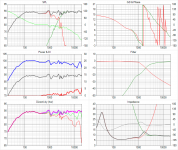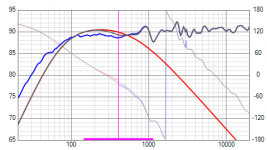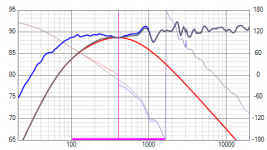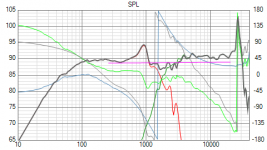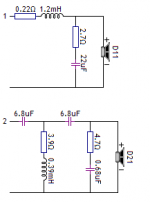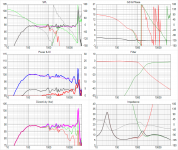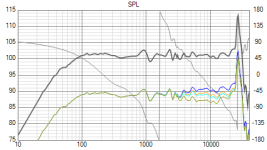I will take a look, its likely the cabinet will need to change.
The crossover will definately need to change. This DS-215 does look like a good option from the Dayton range.
Thank you.! Very grateful of your help.!
I entered the T-S parameters and did a Butterworth maximally flat amplitude bass alignment. This comes out at a much more reasonable 10.3L (practically anything around 10L would be fine.)
Or if you want a little more deep bass at the expense of mid bass a Bessel filter alignment (Which provides a maximally flat response in the time domain - i.e. minimum group delay peaking) and is typically easier to use in a room close to walls requires a volume of 17.5 Litres.
This speaker is much better suited in terms of its T-S parameters to a book shelf design.
I will take a look at the Xover next.
Or if you want a little more deep bass at the expense of mid bass a Bessel filter alignment (Which provides a maximally flat response in the time domain - i.e. minimum group delay peaking) and is typically easier to use in a room close to walls requires a volume of 17.5 Litres.
This speaker is much better suited in terms of its T-S parameters to a book shelf design.
I will take a look at the Xover next.
The Dayton Audio site had the frequency phase and impedance data available which saved tracing it and provided real phase information. The off axis response of the tweeter has been estimated by using the 30deg for both 30 and 15 and using the 60deg for the 45deg (There is no 60deg woofer plot so this cannot be simulated) this means the off axis response of the tweeter is worst case over estimated.
The design has been optimised to try to avoid awkward values. The on axis response has been compromised with the power response to try to give a falling power response with no significant peaks. There is a slight "BBC" dip at around 3kHz as the tweeter becomes dominant and the directivity index dips to attempt to minimise overly bright presentation in this area. the electrical crossover is a 2KHz the acoustic somewhat higher depending on how you average through the peaks and dips in the response.
I have shown both Butterworth and Bessel bass alignments (keep in mind that this will be affected by the baffle set and room response). Bessel would be best if you plan to use a subwoofer with it or you find your room tends to be boomy with speakers close to the wall. Butterworth will provide the best response if you plan to have the speaker away from the wall, you like a lot of bass or you room tends to such up bass (this usually means you have wooden construction walls and the bass is escaping)
For interest I have included what happens if you use the Dayton driver with the crossover from the Scan Speak (The tweeter remains the same) this clearly shows why it is often problematic to swap seemingly similar drivers over.
The design has been optimised to try to avoid awkward values. The on axis response has been compromised with the power response to try to give a falling power response with no significant peaks. There is a slight "BBC" dip at around 3kHz as the tweeter becomes dominant and the directivity index dips to attempt to minimise overly bright presentation in this area. the electrical crossover is a 2KHz the acoustic somewhat higher depending on how you average through the peaks and dips in the response.
I have shown both Butterworth and Bessel bass alignments (keep in mind that this will be affected by the baffle set and room response). Bessel would be best if you plan to use a subwoofer with it or you find your room tends to be boomy with speakers close to the wall. Butterworth will provide the best response if you plan to have the speaker away from the wall, you like a lot of bass or you room tends to such up bass (this usually means you have wooden construction walls and the bass is escaping)
For interest I have included what happens if you use the Dayton driver with the crossover from the Scan Speak (The tweeter remains the same) this clearly shows why it is often problematic to swap seemingly similar drivers over.
Attachments
Thank you for all.! I have compared both data you provided (scanspeak and dayton) and find the Dayton is also a good contender. I hope it sounds good.
I agree the aluminium driver does seem to work well and the crossover looks like it has worked out well. Also spending more time working on crossovers I am remembering more of the techniques I used to use (its been about 10 years since I did my last comercial design). If you do build it I will be interested to hear your impressions of how it sounds. I will send you the design filesso you can adjust it if needed.
Sure, I will build them. I am thinking to buy some of the cabinets Part Express offers. I will buy the drivers as soon as possible and have saved all the data you have provided. Just curious, have you worked as an speaker designer for some speaker company ?? As you said, it has been more than 10 years you did your last commercial design or you just do it as a hobby??
Very grateful of your tremendous help.!
Very grateful of your tremendous help.!
@gfiandy:
First of all really impressive support from your side.
But...
apart from you most likely squeezing all out of it don't you think the design is somewhat compromised because of physics?
First of all really impressive support from your side.
But...
apart from you most likely squeezing all out of it don't you think the design is somewhat compromised because of physics?
Yes, it is difficult to cross a 8 inch into a dome tweeter but its what the origional poster wants to try and as you say I have done my best to minimise the compromises. Lots of speakers were designed like this in the 70s and 80s and whilst they are a compromise, all speakers are in some way. That and the 8 inch he has chosen is significantly better off axis than most of the drivers from the 70s!
I have designed speakers for - Meridian Audio (Active and passive), Tannoy (active convesion of a dual concentric) and ARCAM (passive and an active subwoofer) but as I said that was a long time ago now.
Just curious, have you worked as an speaker designer for some speaker company ?? As you said, it has been more than 10 years you did your last commercial design or you just do it as a hobby??
I have designed speakers for - Meridian Audio (Active and passive), Tannoy (active convesion of a dual concentric) and ARCAM (passive and an active subwoofer) but as I said that was a long time ago now.
I have designed speakers for - Meridian Audio (Active and passive), Tannoy (active convesion of a dual concentric) and ARCAM (passive and an active subwoofer) but as I said that was a long time ago now.
Oh God.! No wonder you have shown a great level of expertise with all you support and explanations. I will be more than happy to build them knowing that someone with your knowledge and experience has done all the technical part for me. They have to sound good for sure. Thank you so much for all.! I have never owned Tannoy Dual Concentric speakers but have dreamed it. Many years ago, I listened to a pair of Monitor Gold or Red (not sure which) all I know they were 10" dual concentric, and it has been one of the best, if not the best Hi-Fi sound, I have ever listened to. I know Meridian is "top class" but never listened any gear from them. Arcam is another brand I love. I owned a DVD player from Arcam that was an excellent equipment.!
Tannoy 10" dual concentric
One of the speakers on my wishlist for when money becomes no object.
dave
I also can say that vintage Altec 602a Duplex are between the bests I have listened to. All vintage Tannoy Dual Concentric, top class.!
Couldn't agree more re Tannoy Dual-Concentrics, I own two pairs of 12"s. 😀
They get even better when you remove bass duties from them, the midrange cleans up nicely when the cone doesn't have to move that much.
Still dream of some 10 or 12 inch Monitor Golds with new coils though...
They get even better when you remove bass duties from them, the midrange cleans up nicely when the cone doesn't have to move that much.
Still dream of some 10 or 12 inch Monitor Golds with new coils though...
All vintage Tannoy Dual Concentric, top class
Not all. We built a nice box for a set of 12” Gold with the original XOs and while decent was not outstanding. A good chance the age of the XO wa sholding them back.
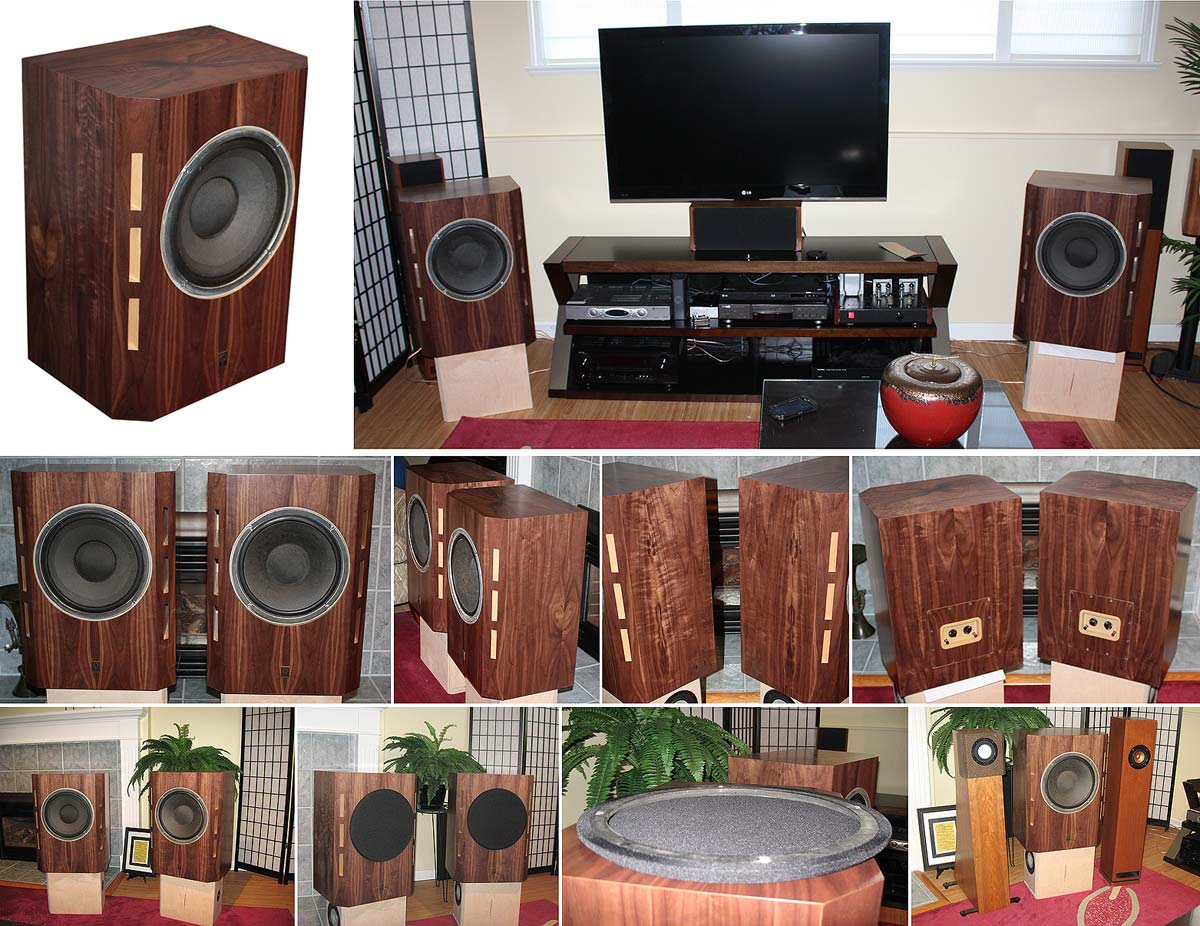
dave
Not all. We built a nice box for a set of 12” Gold with the original XOs and while decent was not outstanding. A good chance the age of the XO wa sholding them back.
I bet the old crossovers were the culprit you didn't like them.!
One indeed has to be suspicious of the veracity of 50 (or so) year old capacitors. Much better ones are made today. I also find speakers that have not been EnABLed are missing something.
dave
dave
By the way, looking to the pictures you posted, I want to ask you if they are real wood ?? MDF ?? They look very nice. It is a good job building those boxes. Who did the finish yourself ?? If so, it looks like you have all the tools and skills to work with wood. Congratulations.!
Chris & Bernie are responsible for our builds, Chris the majority. Chris uses quality plywood (MurphyPly recently) and veneer. That is what the Tan-Ken are. Bernie most often uses solid wood and produces literally works of art.
MDF is not suitable for building speakers.
dave
MDF is not suitable for building speakers.
dave
I was a bit concerned about the 1R Ohm resistor in the tweeter crossover. The tweeter needs to be padded slightly to match the Dayton woofer as it is not as sensitive as the Scan Speak one. This is a common requirement and the approach I used is a common one.
However this tweeter has such an extreme resonance at 27kHz I am concerned that putting a 1R in series with it will mean the amplifier has reduced damping control over it. (It not much good having a fabulous amplifier with a massive damping factor if the speaker is the other side of a resistor)
So I have come up with an alternative approach that requires no changes to the Xover region (so you could try both if you want to) and provides a convenient way to slightly adjust the HF level independently of the Xover components.
It uses a C-R filter to adjust the HF. The cap attenuates the signal over the top end and the resistor prevents the load on the amplifier becoming entirely capacitive at high frequencies. (which can make some amplifiers marginally stable and ring a bit and poorly designed amplifiers might actually become unstable and be damaged)
Attached is the updated Xover the extra parts should be relatively cheap as the capacitor is fairly small and resistors are not expensive. The resistor is set at 4.7R as this is a reasonable load to place on the amplifier at high frequencies when all the capacitors basically look like short circuits. In the impedance plot you can see how the impedance falls at high frequencies it will level out at very high frequencies to 4.7R in parallel with the tweeter inductance.
The capacitor at 0.68uF gives a good approximation of what the 1R did. I have also included a plot with this circuit removed completely, 1uF and 2.2uF so you can see how it behaves going up (removed - Blue) and down (1uF - Light blue and 2.2uF - Yellow). As the capacitance gets higher the 4.7R dominates above 10KHz, hence you get less attenuation so at 2.2uF you get a bit of a lift above 10KHz.
I think this approach will give you better control of the tweeter, as at high frequencies the amplifier has a direct path to the voice coil of the tweeter. It also provides a 4.7R load directly on the tweeter at high frequencies when the 0.68uF cap will behave like a short circuit, this should help to provide some damping and some attenuation as well.
However this tweeter has such an extreme resonance at 27kHz I am concerned that putting a 1R in series with it will mean the amplifier has reduced damping control over it. (It not much good having a fabulous amplifier with a massive damping factor if the speaker is the other side of a resistor)
So I have come up with an alternative approach that requires no changes to the Xover region (so you could try both if you want to) and provides a convenient way to slightly adjust the HF level independently of the Xover components.
It uses a C-R filter to adjust the HF. The cap attenuates the signal over the top end and the resistor prevents the load on the amplifier becoming entirely capacitive at high frequencies. (which can make some amplifiers marginally stable and ring a bit and poorly designed amplifiers might actually become unstable and be damaged)
Attached is the updated Xover the extra parts should be relatively cheap as the capacitor is fairly small and resistors are not expensive. The resistor is set at 4.7R as this is a reasonable load to place on the amplifier at high frequencies when all the capacitors basically look like short circuits. In the impedance plot you can see how the impedance falls at high frequencies it will level out at very high frequencies to 4.7R in parallel with the tweeter inductance.
The capacitor at 0.68uF gives a good approximation of what the 1R did. I have also included a plot with this circuit removed completely, 1uF and 2.2uF so you can see how it behaves going up (removed - Blue) and down (1uF - Light blue and 2.2uF - Yellow). As the capacitance gets higher the 4.7R dominates above 10KHz, hence you get less attenuation so at 2.2uF you get a bit of a lift above 10KHz.
I think this approach will give you better control of the tweeter, as at high frequencies the amplifier has a direct path to the voice coil of the tweeter. It also provides a 4.7R load directly on the tweeter at high frequencies when the 0.68uF cap will behave like a short circuit, this should help to provide some damping and some attenuation as well.
Attachments
- Status
- Not open for further replies.
- Home
- Loudspeakers
- Multi-Way
- DIY vs brand speaker

